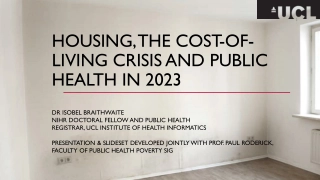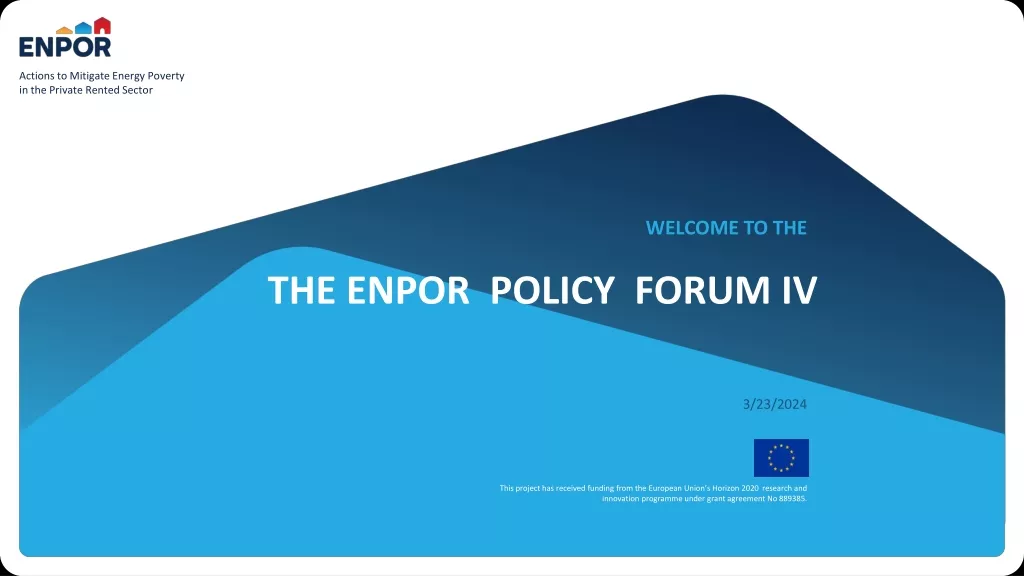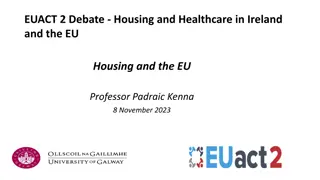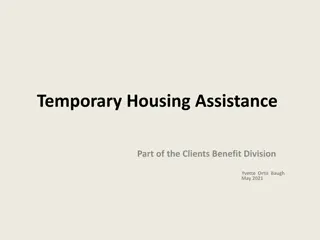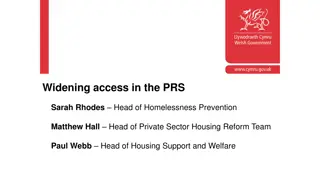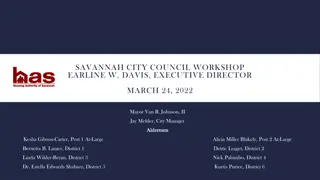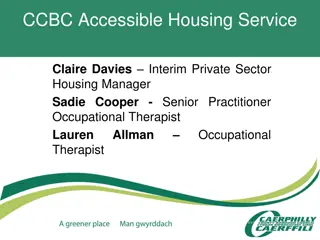Private Rented Housing Sector in the UK: Insights and Comparisons
The private rented housing sector in the UK and other advanced countries, with a focus on size, composition, policy challenges, affordability, quality, and security. Examining changes in the proportion of households in the private rented and social rented sectors over the past decade, along with insights into incentivizing better quality and improved affordability.
Download Presentation

Please find below an Image/Link to download the presentation.
The content on the website is provided AS IS for your information and personal use only. It may not be sold, licensed, or shared on other websites without obtaining consent from the author.If you encounter any issues during the download, it is possible that the publisher has removed the file from their server.
You are allowed to download the files provided on this website for personal or commercial use, subject to the condition that they are used lawfully. All files are the property of their respective owners.
The content on the website is provided AS IS for your information and personal use only. It may not be sold, licensed, or shared on other websites without obtaining consent from the author.
E N D
Presentation Transcript
Ask the Expert The private rented housing sector: The UK and ideas from other countries Professor Michael Oxley Director, Cambridge Centre for Housing Planning Research, Department of Land Economy, University of Cambridge Speaker: Chair: Nigel Keohane Social Market Foundation @esrc Wi-Fi Network: SMF Password: SMF_1989 @SMFthinktank #SMFask
https://encrypted-tbn3.gstatic.com/images?q=tbn:ANd9GcSS2TBIGfnh-1I_z55Xuob-xRCt8MQZQ5FIstqkZcrFQ2STVgYhttps://encrypted-tbn3.gstatic.com/images?q=tbn:ANd9GcSS2TBIGfnh-1I_z55Xuob-xRCt8MQZQ5FIstqkZcrFQ2STVgY
Introduction Private Rented Housing Sector (PRS) in the UK: size composition policy problems: affordability, quality, security PRS in other advanced countries: private ownership and social allocation incentivising better quality and improved affordability
Dwelling stock by tenure: UK, 2014 Owner occupied Private renting Rented from housing associations Rented from local authorities 63% 19% 10% 8% Source: Own calculations from DCLG Live Table 101
Dwelling stock by tenure: England, 2005 and 2015 Owner occupied Private renting Rented from housing associations Rented from local authorities 2005 69% 12% 8% 10% 2015 63% 20% 10% 7% Source: Own calculations from DCLG Live Table 104
Changing Composition of the PRS Over the last decade, the number of families in the private rented sector has increased; the number of families in the social rented sector has decreased. Between 2005-06 and 2015-16, the proportion of households in the private rented sector with children increased from 30% to 36%. Given the sizeable growth in the overall number of private renters over this period, this six percentage point increase equates to about 945,000 more households in the private rented sector with children. Over the same ten year period, the proportion of households in the social rented sector with children decreased from 36% to 32%, which translates to around 123,000 fewer households in the social rented sector with children. There was no change in the proportion of outright owner and mortgagor households with children. Source: English Housing Survey, Headline Report, 2015/16
Affordability of PRS Private renters spend a significantly greater proportion of their income on their housing costs than social renters or those buying with a mortgage. On average, those buying their home with a mortgage spent 18% of their household income on mortgage payments whereas rent payments were 28% of household income for social renters and 35% of household income for private renters. Source: English Housing Survey, Headline Report, 2015/16
What are the problems with the PRS? A flexible tenure of choice for many households, but issues for some households with: Affordability, security of tenure, uncertainty about rents, quality, rogue landlords, high risks and no capital accumulation
2017 Housing White Paper (1) Acknowledges some of the problems of PRS, including noting: high proportions of income spent on rent housing benefits dependency the loss of a PRS tenancy is now the most common cause of homelessness
2017 Housing White Paper (2) Promises more support for institutional investment in the PRS: Encourage more institutional investors into housing, including for building more homes for private rent, and Encourage family-friendly tenancies
The PRS in other countries How big? Definition of PRS? Allocation, rents, security of tenure Individual landlords Taxation
Housing Tenure: Selected Countries % of stock Private Rented Social Rented Owner Occupied England (2015) 20 17 63 Netherlands (2014) 7 33 60 France (2014) 21.9 17.4 57.7 Germany (2014) 50.4 4.2 45.4 USA (2014) 35 1 64 Australia (2011) 4.7 23.4 68.1 Sources: England: DCLG (2016) Live Tables on Dwelling Stock, Live Table 104 Netherlands, France, Germany: The state of housing in the EU 2015 (2015), Housing Europe USA: US Census Bureau, 2010-2104 American Community Survey 5-Year Estimates Australia: Australian Bureau of Statistics
What counts as private rented housing? Categories Ownership Allocation Private ownership by individuals and companies By market forces Market rents 1 Not by market forces Linked to employment or family relationships Private ownership by individuals and companies 2 Not by market forces Social allocation criteria linked to receipt of a tax concession or soft loan Rents limited Incomes of occupants limited Concessions, rent limitations and allocation conditions often time limited Private ownership by individuals and companies 3 Non-profit organisations and public bodies By market forces Market rents 4
Private Social Supply Incentives: Examples Low Income Housing Tax Credits support some privately owned housing with rent restrictions and income related allocation conditions. USA National Rental Affordability scheme gives tax credits for building of privately owned housing (and housing owned by non-profit organisations), with rent restrictions and income-related allocation conditions. As yet on a small scale to private investors. Australia Tax incentives (principally generous depreciation allowances) and soft loans for some privately owned housing, with rent restrictions and income-related allocation conditions. France Until 2005, generous depreciation allowances for privately owned housing, with rent restrictions and income-related allocation conditions. Germany
Market Rents? Mainly market rents Some element of control on increases for some properties in some states Restrictions on rent levels and increases for tax subsidised properties USA Mainly market rents Some element of control over rent increases to keep them in line with market levels and to prevent increase in early months of contract Australia Rents for new contracts set freely Limits on increases related to inflation Rent limits for subsidised properties France Rents for new contracts set freely Limits on increases for sitting tenants linked to market conditions New rent controls Germany England Mainly market rents
Security of Tenure Limited security of tenure which depends on the contract Typically six months or one year but can be less or more USA Limited security of tenure which depends on the contract Typically six months or one year but can be less or more Australia Strong security of tenure Standard contract is 3 years (individual landlords) or 6 years (other landlords) Termination of contract only in limited circumstances France Strong security of tenure. Length of tenancy in principle indefinite. Notice periods of 3 to 9 months depending on how long the tenancy has run for Termination of contract only in limited circumstances e.g. rent arrears, landlord needs dwelling for own family Sale of dwelling does not break the lease Germany Limited security of tenure which depends on the contract Typically no more than six months and, in many cases, 2 months England
Individual Investors % of PRS stock USA 66% Australia 60% France 96% Germany 62% England 88%
Taxation of Individual Investors CGT system discourages short term holding of the investment Cost Losses allowable against other income deductions against rental income Depreciation allowance USA YES YES YES YES Australia YES YES YES YES France YES YES YES YES Germany YES YES YES YES England YES NO NO NO
Subsidy Taxonomy Object Subsides Subject Subsidies Conditional Object Subsidies
Conditional Object Subsidies Conditional object subsidies can provide incentives to: Promote allocation to those in need Limit rents Minimum quality standard
Key lessons from the PRS in other countries Tax incentives can help: o to increase PRS supply o to promote improvements in quality o to influence allocation and rents Individual landlords are important
International studies of Private Rented Housing: some references CCHPR & LSE (2016) Understanding the role of private renting a four country case study Oxley, MJ (2014) Boosting the supply of affordable rented housing in the UK: learning from other countries, ESRC Impact Acceleration Account (IAA) CCHPR (2012) The Private Rented Sector in the New Century: A Comparative Approach Oxley, MJ, Lishman, R, Brown, T, Haffner, MEA & Hoekstra, JSCM (2010) Promoting investment in private rented housing supply: International policy comparisons, London: Department for Communities and Local Government Haffner, MEA, Hoekstra, JSCM, Oxley, MJ & Heijden, HMH van der (2009) Bridging the gap between social and market rented housing in six European countries? Amsterdam: IOS Press


